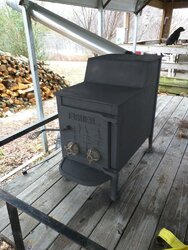I just recently purchased a pretty nice Momma Bear for $100! My question is, on the back of the stove under the exhaust is a seam running across the stove that I can see just a little daylight coming through. Is this normal or do I need to seal it?
Momma Bear question
- Thread starter Tuxmachine
- Start date
-
Active since 1995, Hearth.com is THE place on the internet for free information and advice about wood stoves, pellet stoves and other energy saving equipment.
We strive to provide opinions, articles, discussions and history related to Hearth Products and in a more general sense, energy issues.
We promote the EFFICIENT, RESPONSIBLE, CLEAN and SAFE use of all fuels, whether renewable or fossil.


